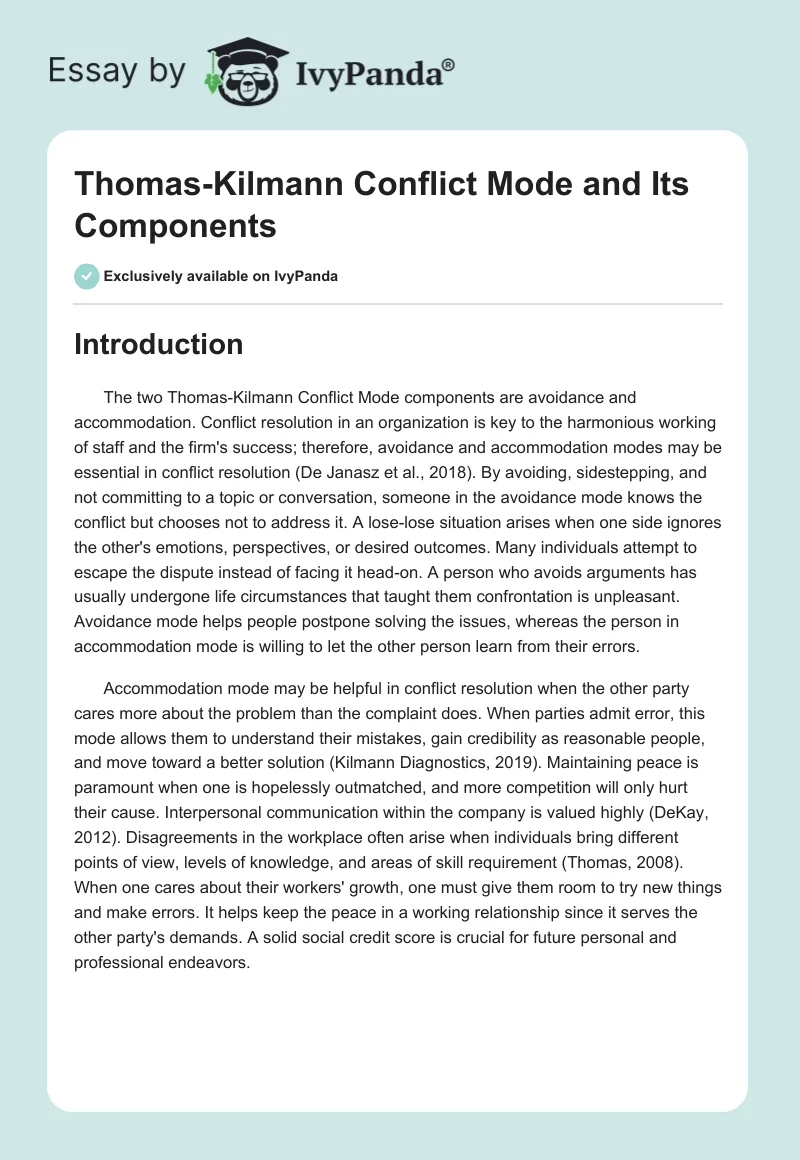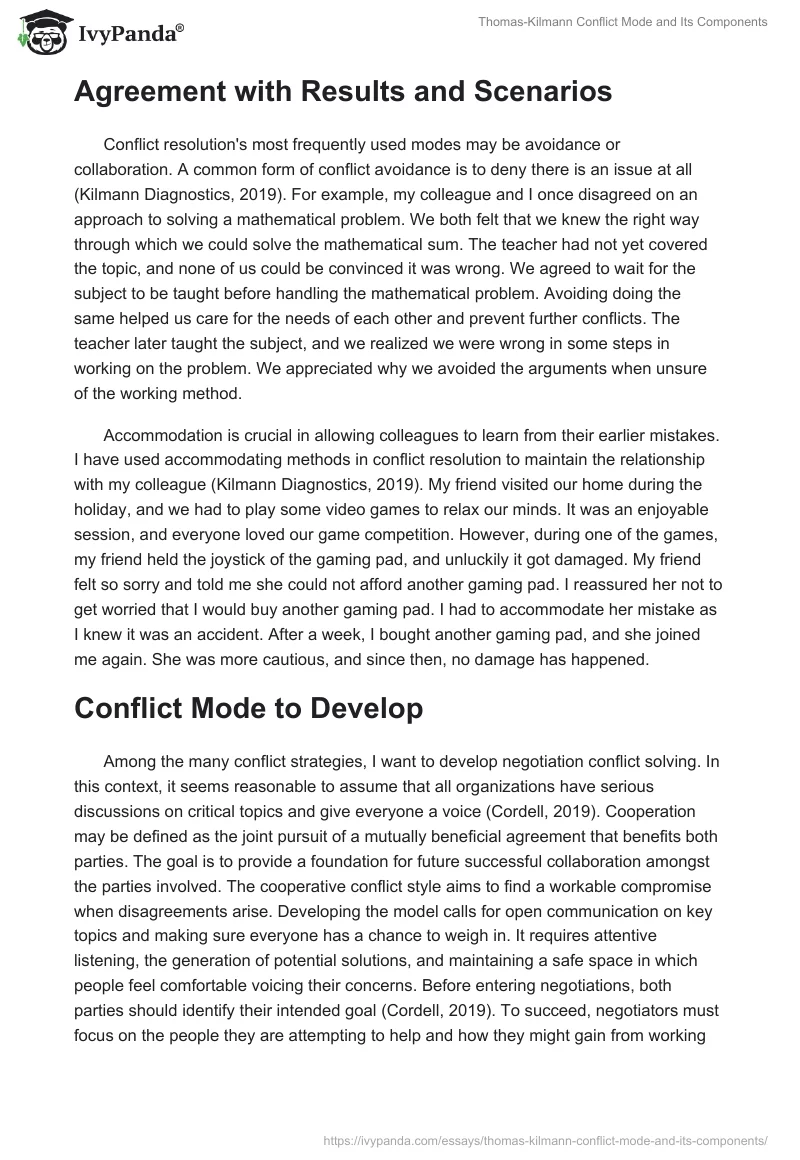Introduction
The two Thomas-Kilmann Conflict Mode components are avoidance and accommodation. Conflict resolution in an organization is key to the harmonious working of staff and the firm’s success; therefore, avoidance and accommodation modes may be essential in conflict resolution (De Janasz et al., 2018). By avoiding, sidestepping, and not committing to a topic or conversation, someone in the avoidance mode knows the conflict but chooses not to address it.
A lose-lose situation arises when one side ignores the other’s emotions, perspectives, or desired outcomes. Many individuals attempt to escape the dispute instead of facing it head-on. A person who avoids arguments has usually undergone life circumstances that taught them confrontation is unpleasant. Avoidance mode helps people postpone solving the issues, whereas the person in accommodation mode is willing to let the other person learn from their errors.
Accommodation mode may be helpful in conflict resolution when the other party cares more about the problem than the complaint does. When parties admit error, this mode allows them to understand their mistakes, gain credibility as reasonable people, and move toward a better solution (Kilmann Diagnostics, 2019). Maintaining peace is paramount when one is hopelessly outmatched, and more competition will only hurt their cause. Interpersonal communication within the company is valued highly (DeKay, 2012).
Disagreements in the workplace often arise when individuals bring different points of view, levels of knowledge, and areas of skill requirement (Thomas, 2008). When one cares about their workers’ growth, one must give them room to try new things and make errors. It helps keep the peace in a working relationship since it serves the other party’s demands. A solid social credit score is crucial for future personal and professional endeavors.
Agreement with Results and Scenarios
Conflict resolution’s most frequently used modes may be avoidance or collaboration. A common form of conflict avoidance is to deny there is an issue at all (Kilmann Diagnostics, 2019). For example, my colleague and I once disagreed on an approach to solving a mathematical problem. We both felt that we knew the right way through which we could solve the mathematical sum. The teacher had not yet covered the topic, and none of us could be convinced it was wrong. We agreed to wait for the subject to be taught before handling the mathematical problem. Avoiding doing the same helped us care for the needs of each other and prevent further conflicts. The teacher later taught the subject, and we realized we were wrong in some steps in working on the problem. We appreciated why we avoided the arguments when unsure of the working method.
Accommodation is crucial in allowing colleagues to learn from their earlier mistakes. I have used accommodating methods in conflict resolution to maintain the relationship with my colleague (Kilmann Diagnostics, 2019). My friend visited our home during the holiday, and we had to play some video games to relax our minds. It was an enjoyable session, and everyone loved our game competition. However, during one of the games, my friend held the joystick of the gaming pad, and unluckily it got damaged. My friend felt so sorry and told me she could not afford another gaming pad. I reassured her not to get worried that I would buy another gaming pad. I had to accommodate her mistake as I knew it was an accident. After a week, I bought another gaming pad, and she joined me again. She was more cautious, and since then, no damage has happened.
Conflict Mode to Develop
Among the many conflict strategies, I want to develop negotiation conflict solving. In this context, it seems reasonable to assume that all organizations have serious discussions on critical topics and give everyone a voice (Cordell, 2019). Cooperation may be defined as the joint pursuit of a mutually beneficial agreement that benefits both parties. The goal is to provide a foundation for future successful collaboration amongst the parties involved. The cooperative conflict style aims to find a workable compromise when disagreements arise.
Developing the model calls for open communication on key topics and making sure everyone has a chance to weigh in. It requires attentive listening, the generation of potential solutions, and maintaining a safe space in which people feel comfortable voicing their concerns. Before entering negotiations, both parties should identify their intended goal (Cordell, 2019). To succeed, negotiators must focus on the people they are attempting to help and how they might gain from working together to resolve a dispute. Negotiators must take active measures to reduce or eliminate conflict and foster a constructive environment.
Conclusion
In conclusion, avoidance and conflict modes may help resolve disputes. It is possible to employ accommodation when someone admits they were wrong; doing so helps them grow as persons and establishes their reputation among them. Peacekeeping is of utmost importance when hopelessly overwhelmed since further competitiveness would only hinder their cause under the accommodation paradigm. Thomas-conflict Kilmann’s mode may have inspired the conflict resolution strategy of negotiation. Successful negotiators keep in mind the interests of the parties they are seeking to aid and the potential benefits to be gained by all parties involved in reaching a compromise.
References
Cordell, A. (2019). The negotiation handbook. Routledge.
De Janasz, S., Dowd, K. O., & Schneider, B. Z. (2018). Interpersonal skills in organizations. New York, NY Mcgraw-Hill Education.
DeKay, S. H. (2012). Interpersonal communication in the workplace: A largely unexplored region. Business Communication Quarterly, 75(4), 449-452. Web.
Kilmann Diagnostics. (2019). An Overview of the Thomas-Kilmann Conflict Mode Instrument (TKI) A long-term collaboration by Kenneth W. Thomas and Ralph H. Kilmann – Kilmann Diagnostics. Kilmann Diagnostics. Web.
Thomas, K. (2008). Making conflict management a strategic advantage (pp. 1–9). Web.


